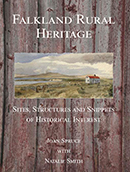PORT HOWARD
|
|
Port Howard is on the north-east of West Falklands, on an inlet of Falkland Sound, and on the slopes of Mount Maria (2158 ft).
The settlement has two airstrips and hosts the West Terminal of the East-west Falkland ferry. It is linked to other settlements by a network of roads.
One of the few original farms not to have been sub-divided, Port Howard is a large 800sq km (200,000ac) sheep farm supporting 40,000 sheep. There are around 20 permanent residents but the settlement often has transitory residents staying at Port Howard Lodge, originally the new manager’s house built in 1952.
|
History
In 1866 James Ludgrove Waldron, a Wiltshire sheep farmer looking for somewhere to establish a sheep farm, requested a lease for 42,000 acres of West Falkland. In June 1867 West Falklands officially opened to settlers and on 15 November 1867 he and his brother Henry took out a lease on Port Howard. Also on board were wooden sectional buildings. Jacob Lee was hired in 1870. James Waldron had the foresight to realise that the Falkland Islands were better suited to sheep farming than cattle. They arrived in September 1867, having chartered the Diana, a barque of 223 tons to bring all his requirements from England which included Exmoor sheep and some Merinos which he picked up in Montevideo. His enterprise flourished, despite the Falkland Islands Company refusing to sell stock to him. Houses, a wool shed and a dip were in place by 1876. Horses were imported from Rio Negro. Several gauchos were employed to kill the wild cattle, necessary to make way for the sheep but also for their hides which gave some ready income. Mr Cobb wrote in 1876 that the supply of hides from wild cattle at Port Howard ‘will not last much longer’. Waldron invested heavily in establishing and stocking his station and was noted for being fair and considerate to his shepherds and labourers. In 1888 the settlement had seven houses at the settlement and five outside shepherds’ houses. The population was 42. In 1893 James Crook Smith constructed a 168ft bridge over the Warrah River. In 1894 he was constructing the first ‘long dip’ in the Falkland Islands at Port Howard. Long dips became important in the fight against sheep scab which was rife in the islands. A telephone line between Port Howard and Little Chartres (the exchange at Goring House) was erected at the end of World War 1.
After the Waldron’s retirement and James left to return to England, Port Howard remained in the Waldron family under management, firstly by E G Matthews who was married to a Waldron niece and later by Reginald Pole-Evans followed by his son Douglas. After the retirement of Douglas, Sydney Lee became manager. In 1987 J L Waldron Ltd sold Port Howard to the Falkland Islands Government on the condition that the farm was not sub-divided. Port Howard Farm Ltd was created with managers and employees buying into the company.
|
Sources include: Report on the Blue Book for 1888/89, Unspoilt Beauty of the Falkland Islands -Algernon Asprey text by Phyllis Rendall, Falkland Rural Heritage- Joan Spruce with Natalie Smith, fig.gov.fk/Jane Cameron National Archives /Buildings/ Land/General/Early leases of land post 1842,nationalarchives.gov.fk /Jane Cameron National Archives /People/19century families, The Dictionary of Falklands Biography (including South Georgia) - Edited by David Tatham,
Photographic credits: Emma Brook
Can you add/ correct any information or supply photographs for this page, past or present? Contact: falklands.southatlantic@gmail.com
Photographs and Images Copyright: The images on this site have been bought under licence or have been used with the permission of their owners. They may not be copied or downloaded in any form without their owner's consent. |
     |
|
| |
|
| |

|
| |
| |
| |
|
| |
|
|
 |
Find out more about Port Howard's past |
| |
| |
| |
| |
|

